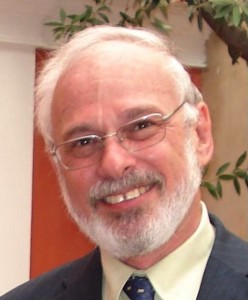Psychedelic therapy refers to the proposed use of psychedelic drugs,such as psilocybin,ayahuasca,LSD,and MDMA,to treat mental disorders. As of 2021,psychedelic drugs are controlled substances in most countries and psychedelic therapy is not legally available outside clinical trials,with some exceptions.
Biological psychiatry or biopsychiatry is an approach to psychiatry that aims to understand mental disorder in terms of the biological function of the nervous system. It is interdisciplinary in its approach and draws on sciences such as neuroscience,psychopharmacology,biochemistry,genetics,epigenetics and physiology to investigate the biological bases of behavior and psychopathology. Biopsychiatry is the branch of medicine which deals with the study of the biological function of the nervous system in mental disorders.

Hallucinogen persisting perception disorder (HPPD) is a non-psychotic disorder in which a person experiences apparent lasting or persistent visual hallucinations or perceptual distortions after using drugs,including but not limited to psychedelics,dissociatives,entactogens,tetrahydrocannabinol (THC),and SSRIs. Despite being designated as a hallucinogen-specific disorder,the specific contributory role of psychedelic drugs is unknown.
Neuropsychiatry is a branch of medicine that deals with psychiatry as it relates to neurology,in an effort to understand and attribute behavior to the interaction of neurobiology and social psychology factors. Within neuropsychiatry,the mind is considered "as an emergent property of the brain",whereas other behavioral and neurological specialties might consider the two as separate entities. Those disciplines are typically practiced separately.
Treatment-resistant depression (TRD) is major depressive disorder in which an affected person does not respond adequately to at least two different antidepressant medications at an adequate dose and for an adequate duration. Inadequate response has most commonly been defined as less than 25% reduction in depressive symptoms following treatment with an antidepressant. Many clinicians and researchers question the construct validity and clinical utility of treatment-resistant depression as currently conceptualized.
The biopsychiatry controversy is a dispute over which viewpoint should predominate and form a basis of psychiatric theory and practice. The debate is a criticism of a claimed strict biological view of psychiatric thinking. Its critics include disparate groups such as the antipsychiatry movement and some academics.
Psychiatric genetics is a subfield of behavioral neurogenetics and behavioral genetics which studies the role of genetics in the development of mental disorders. The basic principle behind psychiatric genetics is that genetic polymorphisms are part of the causation of psychiatric disorders.

Calcium channel,voltage-dependent,L type,alpha 1C subunit is a protein that in humans is encoded by the CACNA1C gene. Cav1.2 is a subunit of L-type voltage-dependent calcium channel.

Disrupted in schizophrenia 1 is a protein that in humans is encoded by the DISC1 gene. In coordination with a wide array of interacting partners,DISC1 has been shown to participate in the regulation of cell proliferation,differentiation,migration,neuronal axon and dendrite outgrowth,mitochondrial transport,fission and/or fusion,and cell-to-cell adhesion. Several studies have shown that unregulated expression or altered protein structure of DISC1 may predispose individuals to the development of schizophrenia,clinical depression,bipolar disorder,and other psychiatric conditions. The cellular functions that are disrupted by permutations in DISC1,which lead to the development of these disorders,have yet to be clearly defined and are the subject of current ongoing research. Although,recent genetic studies of large schizophrenia cohorts have failed to implicate DISC1 as a risk gene at the gene level,the DISC1 interactome gene set was associated with schizophrenia,showing evidence from genome-wide association studies of the role of DISC1 and interacting partners in schizophrenia susceptibility.
Rs6265,also called Val66Met or G196A,is a gene variation,a single nucleotide polymorphism (SNP) in the BDNF gene that codes for brain-derived neurotrophic factor.
Hallucinogens are a large and diverse class of psychoactive drugs that can produce altered states of consciousness characterized by major alterations in thought,mood,and perception as well as other changes. Most hallucinogens can be categorized as either being psychedelics,dissociatives,or deliriants.
The causes of schizophrenia that underlie the development of schizophrenia,a psychiatric disorder,are complex and not clearly understood. A number of hypotheses including the dopamine hypothesis,and the glutamate hypothesis have been put forward in an attempt to explain the link between altered brain function and the symptoms and development of schizophrenia.
The diagnosis of schizophrenia,a psychotic disorder,is based on criteria in either the American Psychiatric Association's Diagnostic and Statistical Manual of Mental Disorders,or the World Health Organization's International Classification of Diseases (ICD). Clinical assessment of schizophrenia is carried out by a mental health professional based on observed behavior,reported experiences,and reports of others familiar with the person. Diagnosis is usually made by a psychiatrist. Associated symptoms occur along a continuum in the population and must reach a certain severity and level of impairment before a diagnosis is made. Schizophrenia has a prevalence rate of 0.3-0.7% in the United States.

The imprinted brain hypothesis is an unsubstantiated hypothesis in evolutionary psychology regarding the causes of autism spectrum and schizophrenia spectrum disorders,first presented by Bernard Crespi and Christopher Badcock in 2008. It claims that certain autistic and schizotypal traits are opposites,and that this implies the etiology of the two conditions must be at odds.
The evolution of schizophrenia refers to the theory of natural selection working in favor of selecting traits that are characteristic of the disorder. Positive symptoms are features that are not present in healthy individuals but appear as a result of the disease process. These include visual and/or auditory hallucinations,delusions,paranoia,and major thought disorders. Negative symptoms refer to features that are normally present but are reduced or absent as a result of the disease process,including social withdrawal,apathy,anhedonia,alogia,and behavioral perseveration. Cognitive symptoms of schizophrenia involve disturbances in executive functions,working memory impairment,and inability to sustain attention.
Immuno-psychiatry, according to Pariante,is a discipline that studies the connection between the brain and the immune system. It differs from psychoneuroimmunology by postulating that behaviors and emotions are governed by peripheral immune mechanisms. Depression,for instance,is seen as malfunctioning of the immune system.

Psychedelic microdosing involves consuming sub-threshold doses (microdoses) of serotonergic psychedelic drugs like LSD and psilocybin to potentially enhance creativity,energy,emotional balance,problem-solving abilities,and to address anxiety,depression,and addiction. This practice has gained popularity in the 21st century. A June 2024 report by the RAND Corporation suggests that among adults in the United States reporting the use of psilocybin in the past year,nearly half reported microdosing the last time they used it.

Psilocybin therapy is the use of psilocybin in treating a range of mental health conditions,such as depression,anxiety,addictions,obsessive compulsive disorder,and psychosis. It is one of several forms of psychedelic therapy under study. Psilocybin was popularized as a psychedelic recreational drug in the 1970s and was classified as a Schedule I drug by the DEA. Research on psilocybin as a medical treatment was restricted until the 1990s because of the sociocultural fear of dependence on this drug. As of 2022,psilocybin is the most commonly researched psychedelic due to its safety and low potential for abuse and dependence. Clinical trials are being conducted at universities and there is evidence confirming the use of psilocybin in the treatment of depression,PTSD and end of life anxiety.

Prof. Robert Haim Belmaker,is an Israeli psychiatrist who has had major academic positions in Israeli psychiatry since 1974. He had a formative influence on biological directions in Israeli psychiatry. He was Hoffer-Vickar Professor of Psychiatry at Ben-Gurion University of the Negev,Beersheva Israel until his retirement and is now Emeritus.
Psychoplastogens are a group of small molecule drugs that produce rapid and sustained effects on neuronal structure and function,intended to manifest therapeutic benefit after a single administration. Several existing psychoplastogens have been identified and their therapeutic effects demonstrated;several are presently at various stages of development as medications including ketamine,MDMA,scopolamine,and the serotonergic psychedelics,including LSD,psilocin,DMT,and 5-MeO-DMT. Compounds of this sort are being explored as therapeutics for a variety of brain disorders including depression,addiction,and PTSD. The ability to rapidly promote neuronal changes via mechanisms of neuroplasticity was recently discovered as the common therapeutic activity and mechanism of action.







